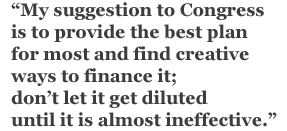 Right now, as we stand on the brink of health care reform, we are locked in a battle to increase the number of health care professionals trained in geriatrics. What would victory look like? To me, victory would be major increases in the number of geriatricians, geriatric nurse practitioners, and geriatric social workers and a significant focus on geriatrics in curriculums for training all health care professionals. Are we there yet? Not even close. That’s why we keep citing the Institute of Medicine report, Retooling for an Aging America: Building the Health Care Workforce. The more this insightful report is discussed and disseminated, the better.
Right now, as we stand on the brink of health care reform, we are locked in a battle to increase the number of health care professionals trained in geriatrics. What would victory look like? To me, victory would be major increases in the number of geriatricians, geriatric nurse practitioners, and geriatric social workers and a significant focus on geriatrics in curriculums for training all health care professionals. Are we there yet? Not even close. That’s why we keep citing the Institute of Medicine report, Retooling for an Aging America: Building the Health Care Workforce. The more this insightful report is discussed and disseminated, the better.
Thankfully, although over a year old now, the report continues to receive attention, even internationally. For example, the International Association of Gerontology and Geriatrics (IAGG) Conference in Paris in July included a workshop on “Building a health care workforce to serve an aging America.” Domestically, in May the annual Princeton Conference on health care  economics and policy also focused on the older population. Titled “How Will We Meet the Health Service Needs of an Aging America?” one of the main areas of discussion focused on how to finance health care reform.
economics and policy also focused on the older population. Titled “How Will We Meet the Health Service Needs of an Aging America?” one of the main areas of discussion focused on how to finance health care reform.
Of course the hot button items were bundling of payments and the cost of rehospitalizations. Most panelists agreed that the system of assigning costs to health care and determining the best methods for reimbursement need to change, but there was little agreement on the best methods of change and how to implement them. It’s no wonder that members of Congress, who don’t have the academic background on these issues as the Princeton speakers have, are struggling to design a system palatable to everyone. My suggestion to Congress is to provide the best plan for most and find creative ways to finance it; don’t let it get diluted until it is almost ineffective. According to the presentations and discussions at the conference, there are many ways to finance health care. The brouhaha about it being too expensive is just diversionary tactics from reform opponents. I don’t believe that we can’t  afford it; I do believe that we can’t afford to continue with the health care non-system that we have.
afford it; I do believe that we can’t afford to continue with the health care non-system that we have.
But back to the IOM report. Not only do we need to find a way to finance health care reform, we need to find a way to ensure that the fastest growing segment of our population, those over 65, have access to adequately trained geriatric health care professionals. The Princeton Conference reiterated this refrain over and over again. In my opinion, it can’t be stated enough--but now it’s time to put the talking to work and find real ways to provide incentives to increase the number of health care professionals appropriately trained to provide quality care for older Americans. The Hartford Foundation has been committed to this mission since 1982. As I mentioned in my short speech at the Princeton Conference, we welcome partnerships in this endeavor and look forward to hearing your ideas on how we can work together to improve health care for older adults.
